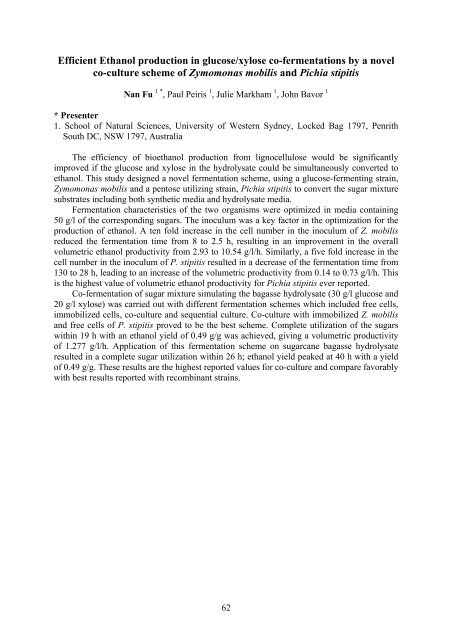Workshop proceeding - final.pdf - Faculty of Information and ...
Workshop proceeding - final.pdf - Faculty of Information and ...
Workshop proceeding - final.pdf - Faculty of Information and ...
Create successful ePaper yourself
Turn your PDF publications into a flip-book with our unique Google optimized e-Paper software.
Efficient Ethanol production in glucose/xylose co-fermentations by a novel<br />
co-culture scheme <strong>of</strong> Zymomonas mobilis <strong>and</strong> Pichia stipitis<br />
Nan Fu 1 * , Paul Peiris 1 , Julie Markham 1 , John Bavor 1<br />
* Presenter<br />
1. School <strong>of</strong> Natural Sciences, University <strong>of</strong> Western Sydney, Locked Bag 1797, Penrith<br />
South DC, NSW 1797, Australia<br />
The efficiency <strong>of</strong> bioethanol production from lignocellulose would be significantly<br />
improved if the glucose <strong>and</strong> xylose in the hydrolysate could be simultaneously converted to<br />
ethanol. This study designed a novel fermentation scheme, using a glucose-fermenting strain,<br />
Zymomonas mobilis <strong>and</strong> a pentose utilizing strain, Pichia stipitis to convert the sugar mixture<br />
substrates including both synthetic media <strong>and</strong> hydrolysate media.<br />
Fermentation characteristics <strong>of</strong> the two organisms were optimized in media containing<br />
50 g/l <strong>of</strong> the corresponding sugars. The inoculum was a key factor in the optimization for the<br />
production <strong>of</strong> ethanol. A ten fold increase in the cell number in the inoculum <strong>of</strong> Z. mobilis<br />
reduced the fermentation time from 8 to 2.5 h, resulting in an improvement in the overall<br />
volumetric ethanol productivity from 2.93 to 10.54 g/l/h. Similarly, a five fold increase in the<br />
cell number in the inoculum <strong>of</strong> P. stipitis resulted in a decrease <strong>of</strong> the fermentation time from<br />
130 to 28 h, leading to an increase <strong>of</strong> the volumetric productivity from 0.14 to 0.73 g/l/h. This<br />
is the highest value <strong>of</strong> volumetric ethanol productivity for Pichia stipitis ever reported.<br />
Co-fermentation <strong>of</strong> sugar mixture simulating the bagasse hydrolysate (30 g/l glucose <strong>and</strong><br />
20 g/l xylose) was carried out with different fermentation schemes which included free cells,<br />
immobilized cells, co-culture <strong>and</strong> sequential culture. Co-culture with immobilized Z. mobilis<br />
<strong>and</strong> free cells <strong>of</strong> P. stipitis proved to be the best scheme. Complete utilization <strong>of</strong> the sugars<br />
within 19 h with an ethanol yield <strong>of</strong> 0.49 g/g was achieved, giving a volumetric productivity<br />
<strong>of</strong> 1.277 g/l/h. Application <strong>of</strong> this fermentation scheme on sugarcane bagasse hydrolysate<br />
resulted in a complete sugar utilization within 26 h; ethanol yield peaked at 40 h with a yield<br />
<strong>of</strong> 0.49 g/g. These results are the highest reported values for co-culture <strong>and</strong> compare favorably<br />
with best results reported with recombinant strains.<br />
62
















